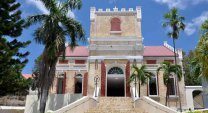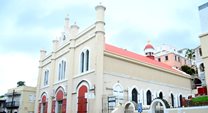CHARLOTTE AMALIE, ST. THOMAS
|
|
Charlotte Amalie has a wealth of historic buildings that provide a glimpse into colonial life. It is listed in the National Registry of Historic Places as an area of particular historic interest. Often referred to as Downtown or just Town, the stylish boutiques and shops on each side of picturesque Main Street were once Danish warehouses. Piers once dotted the Waterfront area providing landing and loading space for trading ships. There are several historic sites, museums, and places of worship that can enrich your knowledge of these islands, our history, people, and culture.
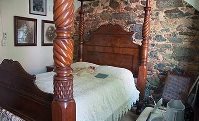
St. Thomas Historical Trust
340-774-5541 or 340-643-6782 5332 Raadets Gade The St. Thomas Historical Trust works to identify, protect and preserve the history, sites and culture of St. Thomas. The mini-museum has five rooms with antique furnishings, artifacts and old photos. Volunteer guides provide information on the items, and on island history. The entrance is through a gated alley; use the buzzer by the gate to ring the museum for entry. Museum Tour - Museum is open Monday-Friday from 10 a.m. - 4 p.m. Closed Weekends and Holidays. Admission: $10 for Adults, Children 12 and under free. The Trust hosts events like traditional broom making, furniture making, and walking tours. The Downtown Walking Tour of Charlotte Amalie’s Historic District, led by a trained and knowledgeable guide, is available Friday mornings except holidays. Learn more>> 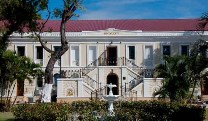
Legislature of the Virgin Islands
340-774-0880 Veterans Drive (Waterfront) ---Just across from Fort Christian The two-story Legislature Building houses the offices of the Virgin Islands Legislature, a fifteen member body in which all the legislative powers of the territory are vested. It enjoys the powers and privileges held by most state legislatures of the Union. The original building was a wooden structure erected in 1828 as barracks for the Danish militia. The present building is a reconstruction and was completed in 1874. Ceremonies transferring ownership of the Danish West Indies to the United States were held in the courtyard. Between 1917 and 1930 it served as barracks for the U.S. Marine Corps and then as the Charlotte Amalie High School. In 1956, it was restored and occupied by the Legislature and the Department of Social Welfare. From about 1970 to present time the building has served solely as the Legislature. 
Fort Christian
340-776-4566 Forte Strade --Just across from the Legislature Governor Jørgen Iversen Dyppel led the second expeditionary force from Denmark to St. Thomas, where he arrived on 25 May 1672. There, he initiated construction of Fort Christian in 1680, named after King Christian V. Fort Christian is at sea level, which was ideal for warding off attackers with canon fire. In the 18th century, the fort was expanded and in 1874 a new entrance with a Victorian Clock tower was added. As the oldest standing structure in the U.S. Virgin Islands, this fort has served as a town center, a government building, and a jail. It currently holds the St. Thomas Museum. The fort is one of 7 National Historic Landmarks in the U.S. Virgin Islands. 
Emancipation Garden Park
Forte Strade --across from the Grand Galleria Between Fort Christian and the Central Post Office is the Emancipation Garden Park, appropriately named in commemoration of Governor Peter von Scholten's emancipation of enslaved people on July 3, 1848. It is the site where the Emancipation Proclamation was read on July 3, 1848. The park was ringed with a fence of old ships' anchor chain and cannons recovered from the harbor. A bust of Denmark’s King Christian IX is situated in the middle of the park. A commemorative plaque, a bronze bust of a freed man blowing a conch shell and a replica of the Liberty Bell are featured. The trees shading the park are Lignum Vitae, one of the hardest and slowest growing trees on earth, and commonly used in colonial times as foundation posts for island buildings. The gazebo hosts concerts and other activities throughout the year, including official government ceremonies. The annual Cultural Food Fair is also held here. 
Grand Hotel
(now the Grand Galleria) 43-46 Norre Gade Just across from Emancipation Garden is the Grand Hotel which was built in 1841 as a commercial hotel and coffee house. It is an excellent example of 19th-century architecture. In its heyday the Hotel was the accommodation of distinguished and well-to-do visitors. It remained a hotel until 1975. Restored, renovated, and renamed Grand Galleria in 2000, it currently houses shops and restaurants as well as the Virgin Islands Children's Museum on the 2nd floor. 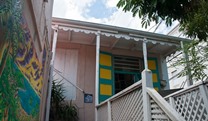
Camille Pissarro Building
and Art Gallery 340-774-4621 14 Main Street World famous Danish-French Impressionist and Neo-Impressionist painter Camille Pissarro was born in this building as Jacob Pizarro in 1830. Before moving to Paris, he worked for his father in a store on Main Street. The second-floor gallery has a few Pissarro paintings on display and a fine collection of original paintings and prints by local and regional artists. 
Government House
340-774-0001 21-22 Kongens Gade (Government Hill) Monday - Friday, 8:00 a.m. - 5:00 p.m. Built in 1867, this neoclassical, gracious 3-story, white brick-and-wood structure with beautifully intricate ironwork along the balconies houses the offices of the Governor of the Virgin Islands. It is a perfect example of the grandeur of official buildings during Danish colonial time. Visitors must check in with the security officer at the entrance. Inside, the staircases are of native mahogany, as are the plaques, hand-lettered in gold with the names of the governors--Danish, Naval and Civilian. Also in the lobby are vintage West Indian furniture, two small paintings by renowned Impressionist artist, Camille Pissarro and three murals by Italian-American artist Peppino Margravite. Brochures detailing the history of the building are available, but you may have to ask for them. 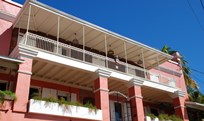
Hotel 1829
340-776-1234 29-30 Kongens Gade (Government Hill) October 20, 2016 - May 1, 2017 Tuesday & Wednesday, 9:00 a.m. - 3:00 p.m. Hotel 1829 was built by wealthy French sea merchant, Alexander Lavalette, in 1829. The initials "AL" are still visible in the wrought-iron work on the front of the hotel. The former private residence, which became a hotel in 1906, is a welcoming pastel coral color with white shutters offering a true, St. Thomas feel. The structure was originally one of the largest homes in that section of town and was ornately decorated with pieces from all over the world. Architecturally, it is unique for it's U-shaped design and the beautiful, West Indian “welcoming arms” front staircase, which flares out at the bottom and frames the world-famous Amber Waterfall Fountain. This handcrafted fountain is made up of more than 12,000 authentic pieces of Amber jewels. The fountain glistens in the sun as the light streams through the courtyard. Inside, the dining room has its original floors, 200-year-old, hand-painted Moroccan glazed tiles laid in a harlequin pattern with terra cotta tiles from Martinique. It also features an incredible original stained glass window by Tiffany called “In Search of the Promised Land”. There is also a massive chess pieces three centuries old. The kitchen was built inside the main house, rare at that time because of fire danger and because few people would tolerate the heat from cooking on top of the hot Caribbean weather. The small room is made of brick, dark wood, and stone and it’s packed with history. The original stove is still here, and the kitchen has been transformed into the magnificently restored Bar 1829. This popular bar and touring the structure are the only areas of the hotel open for business these days. The historic 99 steps line one side of the building. |

99 Steps
Charlotte Amalie is unique for dozens of step streets, or "frigangs" as the Danes called them built to solve the problem of getting around the town's hilly terrain. The "99 Steps" located on Government Hill and built in the mid 1700's are the most popular and likely the most photographed. The 99 steps original name was Store Taarne Gade which means "Greater Tower Street". The picturesque stairway has colorful flowers on either side making it an easy choice for a photo. The bricks used in the steps were brought from Denmark as ballasts in the holds of trade ships traveling to the Virgin Islands. Upon reaching the Virgin Islands, the ballast stones were removed and cargo in the form of sugar and molasses was loaded. Walk to the top (actually 103 steps) and you will find yourself near the foot of more stairs leading to Blackbeard's Castle. 
Blackbeard's Castle
(Skytsborg Tower) 340-776-1234 Lille Taarne Gade October 20, 2016 - May 1, 2017 Tuesday & Wednesday, 9:00 a.m. - 3:00 p.m. St. Thomas Skytsborg Tower (meaning sky tower), was built in 1679 by the Danes as a watchtower for the harbor of Charlotte Amalie. It is located at the highest point on Skytsborg Tower Government Hill. Danish soldiers used Skytsborg as a vantage point to spot enemy ships and protect Fort Christian from attacks. It is not known what year Skytsborg Tower took on the name of "Blackbeard's Castle", but the infamous Edward Teach, commonly known as Blackbeard the Pirate, did sail the Caribbean waters in the early 1700s. It has become part of the lore of the island that he used the Tower as a vantage point for his own treacherous purposes. The castle is one of 7 National Historic Landmarks in the U.S. Virgin Islands. A must see is the Three Queens Fountain, commemorating 3 women who led a successful 1878 insurrection against the Danish Government demanding improved working and living conditions and better wages. Other historic estates include Haagensen House, a 19th century Danish banker's house and Villa Notman, built in 1860 and fully restored. 
Crown House
26 Dronningens Gade (Blackbeard's Hill) Built in 1740 around a smaller Dutch house from the 1600's, Crown House is the stately, three-story West Indian structure Danish Governor Peter von Scholten inhabited until 1822, when as governor he moved to Christiansted, St. Croix, then the capital of the Virgin Islands. Today it is lavish private home, so viewing is limited to the exterior. 
Seven Arches Museum
340-774-9295 Monday to Saturday, by appointment only 5 minutes from Main Street Located directly behind Lt. Governor's Offices on Government Hill Currently undergoing renovation, the Seven Arches Museum is a two-story yellow stone, brick and coral structure which serves as an excellent living example of 18th century Danish West Indian architecture. Built in the late 1700's and named for the seven arches that support the home's main staircase, this is the only private residence museum in St. Thomas that is open to the public. The house is painstakingly decorated as it would have been back in the turn of the century. The museum boasts one of the few remaining outdoor kitchens in the Virgin Islands. It also houses several family heirlooms like the family's jewelry making tools from the 1800's, several Danish West Indian coins, old letters and stamps from the 1800's, as well as a large collection of Royal Copenhagen dishes. A must see attraction at the Seven Arches Museum is the large West Indian mahogany canopy bed and the century plant Christmas tree. The Seven Arches Museum was home to several of the island's most prominent families like the Bonelli's, the De Windt's, the Schaltenbrandt's and the Corneiro's. 
Rothschild Francis Market Square (Market Square)
On the west end of downtown Main Street is the Rothschild Francis Market Square, commonly called Market Square. It was once one of the West Indies' busiest 18th-century markets of enslaved African people. It has since served as a produce market and community meeting venue for nearly two centuries. The cast iron bungalow is dated around 1904. Market women played an important role in the square, selling fruits and goods. The bungalow was controlled by these colorful and spirited ladies. It was rare that a male vendor would sell under the bungalow. French farmers selling functional straw crafts, fish and produce were once commonplace at the Square; they sold their goods from the perimeter of the Bungalow. In January 2013, a pre-Columbian site was discovered here with hundreds of whelk shells and pottery shards pouring out from the newly disturbed soil of a water trench under construction. The site was hand-excavated, and the archaeologists found that they had come across a Saladoid era – 2,500 to 1,400 years ago site which they described as a very rich, major find. Today the Square gets a handful of vendors on any given day, typically Friday and Saturday mornings being most busy. 
The Frenchtown
Heritage Museum 340-714-2583 Rue de St. Barthelemy Tours: Monday - Friday, 10:00 a.m. - 1:00 p.m.and by appointment The Frenchtown Heritage Museum is housed in two small houses, both fine examples of traditional vernacular architecture once common in Frenchtown, and to some degree, still in use today. Step inside the museum and view 400 century-old artifacts residents have donated such as fishing nets, accordions, mahogany furniture, pottery, tools, and photographs. They tell the story of the French-Caribbean people of St. Barthelemy that settled in St. Thomas and of their descendants. The museum also records the genealogies of local families. Historic Places of WorshipAll Saints Cathedral (Episcopal) Church - built in 1848
Christchurch Methodist Church - built in 1912 Frederik Evangelical Lutheran Church - built in 1793 New Herrnhut Moravian Church - built in 1737 Nisky Moravian Church - built in 1771 Saints Peter and Paul Cathedral (Catholic) Church - built in 1848 St. Thomas Reformed Church - built in 1848 St. Thomas Synagogue - built in 1833 |
VIDEOS: ST. THOMAS HISTORIC Sites
|
Video: 1936 St. Thomas, Virgin Islands Travelogue |
Video: 2010 Charlotte Amalie Historic Walking Tour |
|
Video: Blackbeard's Castle, Hotel 1829, & Rum Tours |
Video: Government House Tour |
|
Video: Emancipation Garden Park |
Video: Camille Pissarro Art Gallery |
